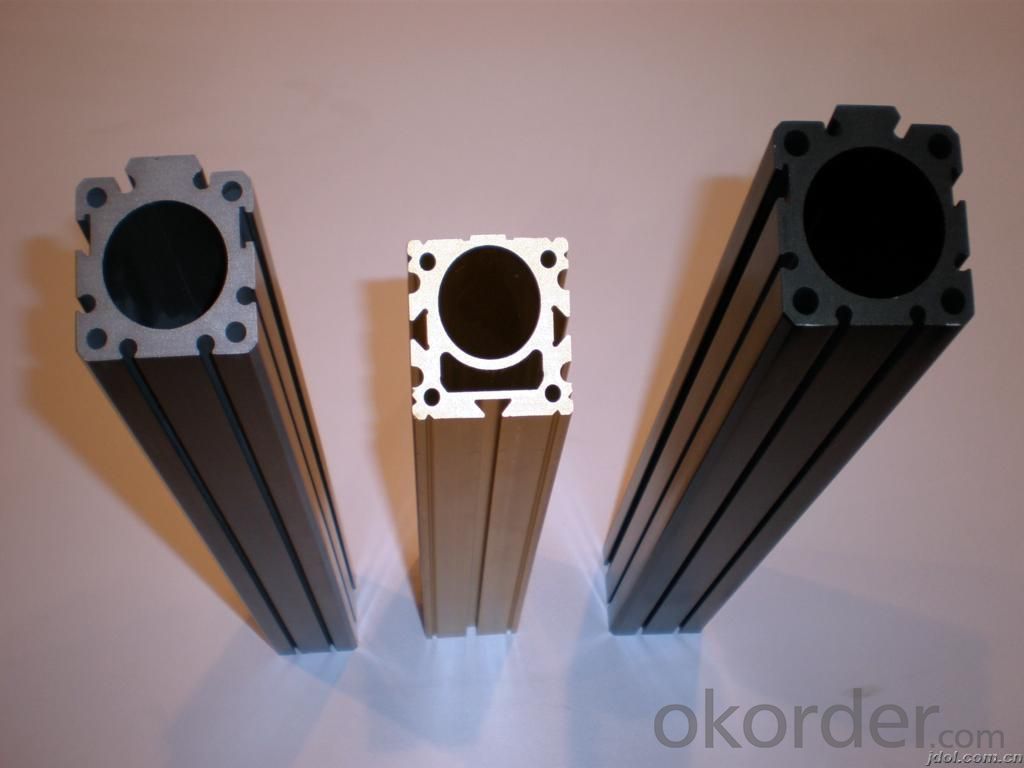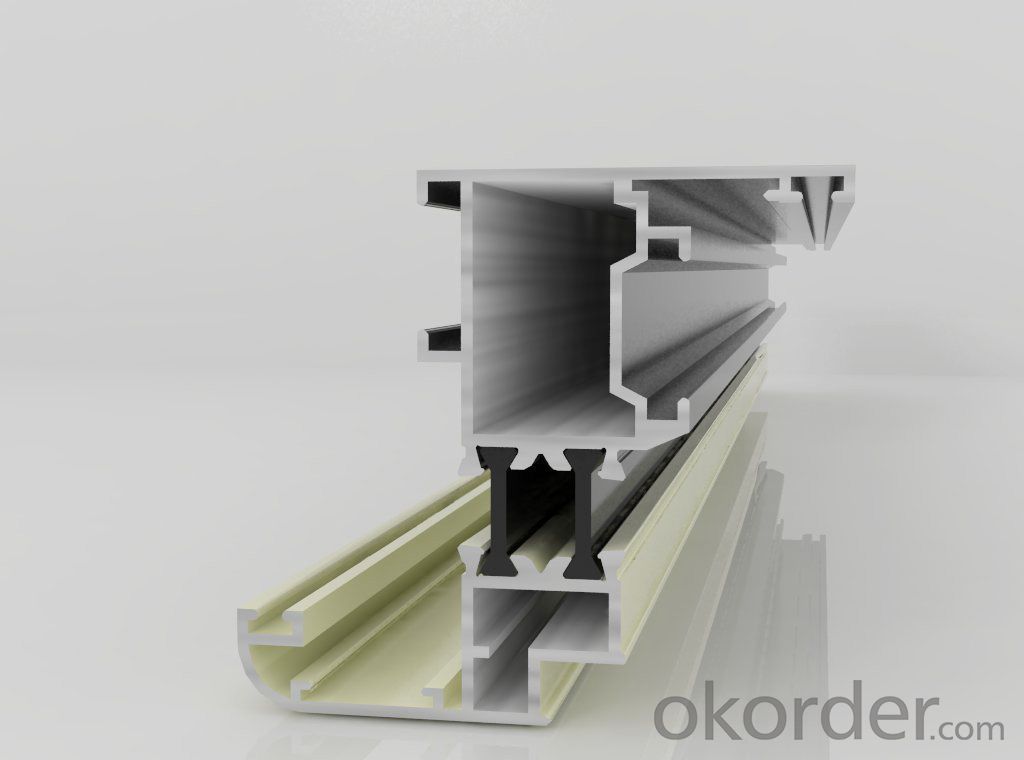Aluminium Profile with Sand Blasting Treatment SA6
- Loading Port:
- Shanghai
- Payment Terms:
- TT OR LC
- Min Order Qty:
- 20 m.t.
- Supply Capability:
- 2000 m.t./month
OKorder Service Pledge
OKorder Financial Service
You Might Also Like
1.Structure of Aluminium Profile with Sand Blasting Treatment SA6 Description:
Anodizing (also spelled anodising, particularly in the UK and Australia) is an electrolytic passivation process used to increase the thickness of the natural oxide layer on the surface of metal parts. Anodized aluminium surfaces, for example, are harder than aluminium but have low to moderate wear resistance that can be improved with increasing thickness or by applying suitable sealing substances.
2.Main Features of theAluminium Profile with Sand Blasting Treatment SA6:
High corrosion-resistance;
weather-resistance;
heat-resistance;
alkali-resistance and impact-resistance properties.
3.Aluminium Profile with Sand Blasting Treatment SA6 Images:



4.Aluminium Profile with Sand Blasting Treatment SA6 Specification:
1. Material: 6063,6061,6060,6005,6005A,etc.
2. Temper: T5 or T6
3. Finish: Mill finish, anodizing, powder coating, electrophoresis, wooden transfer or pvdf/carbon-flouride coated, polishing, brushing, sand blasting
4. Various colors: Silver, bronze, black, gold, blue, grey, champagne, bright, etc.
5. Machining: Cutting, punching, drilling, tapping, milling, bending, welding, CNC etc.
5.FAQ:
①How about your company?
A world class manufacturer & supplier of castings forging in carbon steel and alloy steel,is one of the large-scale professional investment casting production bases in China, consisting of both casting foundry forging and machining factory. Annually more than 8000 tons Precision casting and forging parts are exported to markets in Europe, America and Japan. OEM casting and forging service available according to customer’s requirements.
②How to guarantee the quality of the products?
We have established the international advanced quality management system,every link from raw material to final product we have strict quality test;We resolutely put an end to unqualified products flowing into the market. At the same time, we will provide necessary follow-up service assurance.
- Q:How does the formability of aluminum sheet vary with different alloys?
- The formability of aluminum sheet can vary significantly with different alloys. Some aluminum alloys have excellent formability, allowing for easy bending, shaping, and forming without cracking or tearing. These alloys are commonly used in applications that require complex shapes or intricate designs. On the other hand, certain aluminum alloys may have lower formability, making them more difficult to shape without the risk of deformation or failure. The choice of alloy will depend on the specific requirements of the application and the desired level of formability needed.
- Q:Can 101 aluminum sheets be used in the production of musical instruments?
- Yes, 101 aluminum sheets can be used in the production of musical instruments. They offer good conductivity and durability, making them suitable for various components like instrument bodies, panels, or parts that require lightweight construction.
- Q:This aluminum is on a mobile home. I trying to repaint it and there is alot of areas were rust has ate the metal away. Especially in the seams. How can I get rid of the rust that already exists and stop it from coming back.
- Aluminum doesn`t rust. This is probably tin. If a magnet sticks to it, treat and paint as you would steel.
- Q:What is the fatigue strength of 101 aluminum sheets?
- The maximum stress level that 101 aluminum sheets can endure without experiencing fatigue failure is known as their fatigue strength. Typically, fatigue strength is determined by subjecting the material to repeated cyclic loading until failure occurs. However, it is important to understand that the fatigue strength can vary depending on various factors, such as the thickness of the sheet, its surface condition, heat treatment, and other mechanical properties. Therefore, it is not possible to provide an accurate value for the fatigue strength of 101 aluminum sheets without specific information about these variables. To obtain the fatigue strength of 101 aluminum sheets, it is recommended to refer to the material's technical datasheet or contact the manufacturer or supplier for precise information. They can provide details on the fatigue properties, including the endurance limit or the stress level at which the material can withstand an unlimited number of cycles without experiencing fatigue failure.
- Q:What are the different bending techniques for aluminum sheets?
- There are several bending techniques that can be used for aluminum sheets. Some of the most commonly used techniques include: 1. Air bending: In this technique, a punch is used to apply force on the sheet, which causes it to bend along a straight line. The bend angle is determined by the amount of force applied. 2. Bottom bending: This technique involves clamping the sheet between a bottom tool and a die, while a punch is used to apply force on the sheet from the top. The sheet is bent around the die, resulting in a precise and consistent bend angle. 3. Coining: Coining is a technique in which the sheet is bent using a punch and a die, but with significantly higher force applied compared to other bending techniques. This creates a crisp and sharp bend with minimal springback. 4. Rotary bending: In rotary bending, the sheet is bent around a rotating bending roll. The roll exerts pressure on the sheet, causing it to bend gradually and smoothly. 5. Roll bending: This technique involves passing the aluminum sheet through a series of rollers, which gradually bend the sheet to the desired shape. It is often used for bending large sheets or for creating cylindrical shapes. 6. Press braking: Press braking is a versatile technique that uses a press brake machine to bend the sheet. The machine consists of a punch, a die, and a back gauge, which allows for precise and repeatable bends. Each bending technique has its own advantages and limitations, and the choice of technique depends on factors such as the desired bend angle, the thickness of the sheet, and the overall shape of the final product. It is important to carefully select the appropriate bending technique to ensure the desired result and avoid any defects or damage to the aluminum sheet.
- Q:i am writing an essay about aluminium recycle,,,, and i would like to knowwhy it is important to recycle aluuminium can, what is so harmful about the wastes and some facts about aluminium.Thanx..... i would love if you give me the site address where i can find such infors...
- aluminium okorder /
- Q:What's the difference between 6061 aluminum plate, 7075 aluminium plate and 6063 aluminum plate?
- Simply put, 6061 and 6063 belong to the 6 series, 6061 hardness in 90HB 6063 in 80HB, suitable for brazing, surface oxidation treatment is better, 7075 T6 hardness in 150HB, hardness is highestUsually 6061 and 6063 can be common
- Q:Can aluminum sheets be used for decorative wall panels?
- Yes, aluminum sheets can be used for decorative wall panels. Aluminum is a versatile material that can be easily manipulated to create various designs and finishes. It is lightweight, durable, and offers a sleek and modern look, making it a popular choice for decorative wall applications.
- Q:I need to know what composite bats do and how (or if) they are better than aluminum bats.
- one is made of aluminum and one isn't. haha i saw a movie and it had a guy and he said yo man i don't have your money
- Q:What are the different methods for cutting aluminum sheets?
- There are several methods commonly used for cutting aluminum sheets. 1. Shearing: This method involves using a sharp blade to make a straight cut through the aluminum sheet. Shearing is typically used for thinner sheets and produces clean, straight cuts. 2. Sawing: Sawing is another method used to cut aluminum sheets. It involves using a saw blade with small teeth to cut through the material. Sawing can be done manually or with the help of power tools such as band saws or circular saws. 3. CNC Machining: Computer Numerical Control (CNC) machining is a highly precise method for cutting aluminum sheets. It involves the use of a computer-controlled machine that follows programmed instructions to cut the sheet into the desired shape. CNC machines can create complex cuts and shapes with high accuracy. 4. Laser Cutting: Laser cutting is a non-contact method that uses a high-powered laser to cut through aluminum sheets. The laser beam melts or vaporizes the aluminum, creating a clean and precise cut. Laser cutting is commonly used for intricate designs and can be done with a high level of precision. 5. Waterjet Cutting: Waterjet cutting uses a high-pressure jet of water mixed with an abrasive material to cut through aluminum sheets. This method is versatile and can be used for a wide range of materials and thicknesses. Waterjet cutting produces clean cuts without generating heat, making it suitable for heat-sensitive materials. 6. Plasma Cutting: Plasma cutting involves the use of a high-temperature plasma arc to cut through aluminum sheets. The plasma arc melts the metal and blows away the molten material, creating a cut. Plasma cutting is commonly used for thicker aluminum sheets and can be done manually or with the help of CNC machines. These methods offer different levels of precision, speed, and suitability for different sheet thicknesses and designs. The choice of cutting method depends on factors such as the desired cut quality, the thickness of the aluminum sheet, and the specific requirements of the project.
1. Manufacturer Overview |
|
|---|---|
| Location | |
| Year Established | |
| Annual Output Value | |
| Main Markets | |
| Company Certifications | |
2. Manufacturer Certificates |
|
|---|---|
| a) Certification Name | |
| Range | |
| Reference | |
| Validity Period | |
3. Manufacturer Capability |
|
|---|---|
| a)Trade Capacity | |
| Nearest Port | |
| Export Percentage | |
| No.of Employees in Trade Department | |
| Language Spoken: | |
| b)Factory Information | |
| Factory Size: | |
| No. of Production Lines | |
| Contract Manufacturing | |
| Product Price Range | |
Send your message to us
Aluminium Profile with Sand Blasting Treatment SA6
- Loading Port:
- Shanghai
- Payment Terms:
- TT OR LC
- Min Order Qty:
- 20 m.t.
- Supply Capability:
- 2000 m.t./month
OKorder Service Pledge
OKorder Financial Service
Similar products
New products
Hot products
Related keywords





























